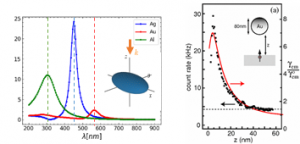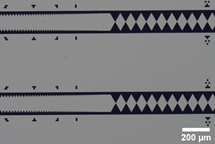This page gives the current projects that we are offering for EPFL students. Most projects can be tailored as bachelor project (quite short), semester project or master project. If you are interested, please check the full description and contact the corresponding collaborator.
Bien que nous donnions cette liste en anglais, le Laboratoire de Nanophotonique & Métrologie (NAM) parle évidemment aussi le français et nous sommes heureux d’accueillir des étudiants francophones!
Fluorescence enhancement for quantum emitters near a plasmonic nanoparticle

The interaction between light and matter stands as a fundamental and pivotal phenomenon in the natural world. In plasmonic systems, the coupling of surface plasmon polaritons with quantum emitters (e.g., semiconducting quantum dots, fluorescent molecules) is a notable instance. This coupling occurs when the emitter is positioned in close proximity to the plasmonic nanostructure, leading to significant effects including enhancement of fluorescence and Raman scattering. The student will have the opportunity to employ electromagnetic theory in systems of interest using computational methods available in the lab, thereby enhancing their understanding and intuition in the subject. Moreover, valuable insights will be gained through hands-on experience in numerical simulations and Python programming, along with the chance for close collaboration with experiments.
Contact: Stavros Athenasiou Full description of the project (PDF)
Monocrystalline silver flakes for applications in plasmonics

Monocrystalline noble metal flakes present a promising material platform for applications in high-quality and low-loss plasmonic systems. This project will involve development of colloidal synthesis recipe for growth of silver crystals and their subsequent nanopatterning. The fabricated monocrystalline silver nanostructures will be then experimentally characterized using scanning electron microscopy (SEM), optical microscopy and spectroscopy. Furthermore, project will also involve numerical simulations for optimization of the nanostructures dimensions and comparison against experimental results.
Contact: Sergejs Boroviks Dull description of the project (PDF)
3D visualization of the boundaries of the dielectrophoretic trapping volume

Dielectrophoresis (DEP) is the effect representing the movement of a polarizable particulate caused by the force originating from the interaction with a non-uniform low-frequency electromagnetic field. DEP is utilized for long-range manipulation (trapping, focusing, separation) of various objects, with microscale precision and has acquired wide attention in a variety of applications, including biosensing, cellular analysis, water purification, and nanotechnology. This project will explore the strength of dielectrophoretics forces.
Contact: Siarhei Zavatski Dull description of the project (PDF)
Engineering plasmonic colours using different dewetting processes

This project aims at coating of large areas with plasmonic nanoparticles using a bottom-up dewetting approach. The dewetting process will be optimised to achieve controlled size distributions and densities of the nanoparticles and, furthermore, adapted to generate custom-made coloured substrates. The achieved coatings will be experimentally characterised with respect to size distribution and density of the particles using scanning electron microscopy (SEM) combined with image analysis. In addition, characterisation using optical microscopy and spectroscopy will be carried out and compared with numerical results achieved by simulation tools developed in the NAM laboratory.
Contact: Christian Santschi Full description of the project (PDF)